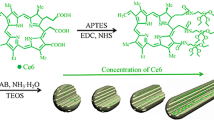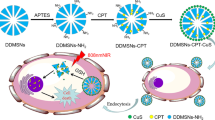Abstract
Mesoporous carriers have been widely used to deliver anticancer drugs due to their unique characteristics. In this work, mesoporous silica nanoparticles (MSN) and mesoporous carbon nanoparticles (MCN) with substantially similar and uniform particle size, specific surface area, and pore size were prepared to compare the photothermal effect, drug loading efficiencies (LE), and drug release properties. In order to improve the dispersion stability and biocompatibility of the carriers, MSN and MCN were grafted with PEG, respectively. The NIR-induced photothermal effect results indicated that MCN had a brilliant photothermal conversion efficiency due to its strong near-infrared absorption capacity, while MSN had no photothermal conversion capability. Moreover, LE of DOX in DOX/MCN-PEG reached 36.58%, higher than that in DOX/MSN-PEG, which was ascribed to non-covalent interaction of π-π stacking and electrostatic attraction. In addition, compared to DOX/MSN-PEG, DOX/MCN-PEG had a significantly increased release rate under NIR laser irradiation due to excellent photothermal conversion capability of MCN-PEG. Furthermore, cell viability assay and cellular uptake experiment results demonstrated that DOX/MCN-PEG showed a synergistic therapeutic effect in the combination of chemotherapy and phototherapy, with a combination index (CI) of 0.238.









Similar content being viewed by others
References
Khatri N, Baradia D, Vhora I, Rathi M, Misra A. cRGD grafted liposomes containing inorganic nano-precipitate complexed siRNA for intracellular delivery in cancer cells. J Control Release. 2014;182(10):45–57.
Strong LE. Hydrogel-nanoparticle composites for optically modulated cancer therapeutic delivery. J Control Release. 2014;178(1):63–8.
Zhenjiang Z, Jing W, Xin N, Tao W, Yinglu J, Xiaochun W, et al. Near infrared laser-induced targeted cancer therapy using thermoresponsive polymer encapsulated gold nanorods. J Am Chem Soc. 2014;136(20):7317–26.
Zongxi L, Barnes JC, Aleksandr B, J Fraser S, Zink JI. Mesoporous silica nanoparticles in biomedical applications. Chem Soc Rev. 2012;41(7):2590–605.
Gu J, Su S, Li Y, He Q, Shi J. Hydrophilic mesoporous carbon nanoparticles as carriers for sustained release of hydrophobic anti-cancer drugs. Chem Commun (Camb). 2011;47(7):2101–3.
Fang Y, Gu D, Zou Y, Wu Z, Li F, Che R, et al. A low-concentration hydrothermal synthesis of biocompatible ordered mesoporous carbon nanospheres with tunable and uniform size. Angew Chem Int Ed Eng. 2010;49(43):7987–91.
Zhu J, Liao L, Bian X, Kong J, Yang P, Liu B. pH-controlled delivery of doxorubicin to cancer cells, based on small mesoporous carbon nanospheres. Small. 2012;8(17):2715–20.
Kim TW, Chung PW, Slowing II, Tsunoda M, Yeung ES, Lin VS. Structurally ordered mesoporous carbon nanoparticles as transmembrane delivery vehicle in human cancer cells. Nano Lett. 2008;8(11):3724–7.
Ma TY, Liu L, Yuan ZY. Direct synthesis of ordered mesoporous carbons. Chem Soc Rev. 2013;42(9):3977–4003.
Yannan Z, Vivero-Escoto JL, Slowing II, Trewyn BG, Victor S-YL. Capped mesoporous silica nanoparticles as stimuli-responsive controlled release systems for intracellular drug/gene delivery. Expert Opin Drug Deliv. 2010;7(9):1013.
Wang H, Sun Y, Yi J, Fu J, Di J, Alonso ADC, et al. Fluorescent porous carbon nanocapsules for two-photon imaging, NIR/pH dual-responsive drug carrier, and photothermal therapy. Biomaterials. 2015;53(5):117–26.
Zhao Q, Wang T, Jing W, Li Z, Jiang T, Gang C, et al. Fabrication of mesoporous hydroxycarbonate apatite for oral delivery of poorly water-soluble drug carvedilol. J Non-Crystal Solids. 2012;358(2):229–35.
Huang-Chiao H, Sutapa B, Gaurav S, Dey SK, Kaushal R. Inorganic nanoparticles for cancer imaging and therapy. J Control Release. 2011;155(3):344–57.
Fangqiong T, Linlin L, Dong C. Mesoporous silica nanoparticles: synthesis, biocompatibility and drug delivery. Adv Mater. 2012;24(12):1504–34.
Jie L, Monty L, Zink JI, Fuyuhiko T. Mesoporous silica nanoparticles as a delivery system for hydrophobic anticancer drugs. Small. 2010;3(8):1341–6.
Hui W, Shi L, Yan T, Zhang J, Zhong Q, Zhang D. Design of graphene-coated hollow mesoporous carbon spheres as high performance electrodes for capacitive deionization. J Mater Chem A. 2014;2(13):4739.
Guo L, Cui X, Li Y, He Q, Zhang L, Bu W, et al. Hollow mesoporous carbon spheres with magnetic cores and their performance as separable bilirubin adsorbents. Chem-Asian J. 2010;4(9):1480–5.
Jain RK. Normalizing tumor microenvironment to treat cancer: bench to bedside to biomarkers. J Clin Oncol. 2013;31(17):2205–U210.
Soucy TA, Smith PG, Milhollen MA, Berger AJ, Gavin JM, Sharmila A, et al. An inhibitor of NEDD8-activating enzyme as a new approach to treat cancer. Nature. 2009;458(7239):732–6.
Li W, Yan Y, Min W, Hong Y, Yang S. An integrated nanoplatform for theranostics via multifunctional core/shell ferrite nanocubes. J Mater Chem B. 2016;4(10):1908–14.
Xiao Q, Zheng X, Bu W, Ge W, Zhang S, Chen F, et al. editors. A core/satellite multifunctional nanotheranostic forin vivo imaging and tumor eradication by radiation/photothermal synergistic therapy. J Am Chem Soc. 2013;135(35):13041–8.
Wang H, Zhao Y-L, Nie G-J. Multifunctional nanoparticle systems for combined chemoand photothermal cancer therapy. Front Mater Sci. 2013;7(2):118–28.
Kai Y, Huan X, Liang C, Chunyang S, Jun W, Zhuang L. In vitro and in vivo near-infrared photothermal therapy of cancer using polypyrrole organic nanoparticles. Adv Mater. 2013;25(7):5586–92.
Ruichan L, Piaoping Y, Fei H, Shili G, Chunxia L, Yunlu D, et al. A yolk-like multifunctional platform for multimodal imaging and synergistic therapy triggered by a single near-infrared light. ACS Nano. 2015;9(2):1630–47.
Fei H, Yang G, Yang P, Yu Y, Lin J. A new single 808 nm NIR light-induced imaging-guided multifunctional cancer therapy platform. Adv Funct Mater. 2015;25(25):3966–76.
Song X, Qian C, Zhuang L. Recent advances in the development of organic photothermal nano-agents. Nano Res. 2015;8(2):340–54.
Liu B, Li C, Xie Z, Hou Z, Cheng Z, Jin D, et al. 808 nm photocontrolled UCL imaging guided chemo/photothermal synergistic therapy with single UCNPs-CuS@PAA nanocomposite. Dalton Trans. 2016;45(33):13061–9.
Li Y, Jiang C, Zhang D, Wang Y, Ren X, Ai K, et al. Targeted polydopamine nanoparticles enable photoacoustic imaging guided chemo-photothermal synergistic therapy of tumor. Acta Biomater. 2017;47:124–34.
Gao Z, Liu X, Deng G, Zhou F, Zhang L, Wang Q, et al. Fe3O4@mSiO2-FA-CuS-PEG nanocomposites for magnetic resonance imaging and targeted chemo-photothermal synergistic therapy of cancer cells. Dalton Trans. 2016;45(34):13456–65.
Yanlan L, Kelong A, Jianhua L, Mo D, Yangyang H, Lehui L. Dopamine-melanin colloidal nanospheres: an efficient near-infrared photothermal therapeutic agent for in vivo cancer therapy. Adv Mater. 2013;25(9):1353–9.
Chen W, Ouyang J, Liu H, Chen M, Zeng K, Sheng J, et al. Black phosphorus nanosheet-based drug delivery system for synergistic photodynamic/photothermal/chemotherapy of cancer. Adv Mater. 2017;29(5)1603864
Peng MY, Zheng DW, Wang SB, Cheng SX, Zhang XZ. Multifunctional nanosystem for synergistic tumor therapy delivered by two-dimensional MoS2. ACS Appl Mater Interfaces. 2017;9(16):13965–75.
Li X, Wang X, Sha L, Wang D, Shi W, Zhao Q, et al. Thermosensitive lipid bilayer-coated mesoporous carbon nanoparticles for synergistic thermochemotherapy of tumor. ACS Appl Mater Interfaces. 2018;10(23):19386–97.
Zhang W, Guo Z, Huang D, Liu Z, Guo X, Zhong H. Synergistic effect of chemo-photothermal therapy using PEGylated graphene oxide. Biomaterials. 2011;32(33):8555–61.
Qin X, Guo Z, Liu Z, Zhang W, Wan M, Yang B. Folic acid-conjugated graphene oxide for cancer targeted chemo-photothermal therapy. J Photochem Photobiol B. 2013;120:156–62.
Xu G, Liu S, Niu H, Lv W, Wu R. Functionalized mesoporous carbon nanoparticles for targeted chemo-photothermal therapy of cancer cells under near-infrared irradiation. RSC Adv. 2014;4(64):33986–97.
Wu, Chao G, Hu H, Jiawen. Stability of thiolated PEG 5000-coated gold colloids: from DLVO stability to steric stability. Acta Chim Sin. 2009;67:1621–5.
Wu C, Guo H, Hu J. Stability of thiolated PEG 5000-coated gold colloids: from DLVO stability to steric stability. Acta Chim Sin. 2009;67:1621–5.
Wang Y, Cui Y, Zhao Y, Zhao Q, He B, Zhang Q, et al. Effects of surface modification and size on oral drug delivery of mesoporous silica formulation. J Colloid Interface Sci. 2018;513:736.
Li X, Yan Y, Lin Y, Jiao J, Wang D, Di D, et al. Hollow mesoporous carbon as a near-infrared absorbing carrier compared with mesoporous carbon nanoparticles for chemo-photothermal therapy. J Colloid Interface Sci. 2017;494:159–69.
He Q, Zhang J, Shi J, Zhu Z, Zhang L, Bu W, et al. The effect of PEGylation of mesoporous silica nanoparticles on nonspecific binding of serum proteins and cellular responses. Biomaterials. 2010;31(6):1085–92.
Jinlou GU, Shasha SU, Zhu M, Yongsheng LI, Zhao W, Duan Y, et al. Targeted doxorubicin delivery to liver cancer cells by PEGylated mesoporous silica nanoparticles with a pH-dependent release profile. Microporous Mesoporous Mater. 2012;161(5):160–7.
Mosmann T. Rapid colorimetric assay for cellular growth and survival: application to proliferation and cytotoxicity assays. J Immunol Methods. 1983;65(1–2):55–63.
Slowing II, Chia-Wen W, Vivero-Escoto JL, Victor S-YL. Mesoporous silica nanoparticles for reducing hemolytic activity towards mammalian red blood cells. Small. 2010;5(1):57–62.
Zhao Q, Liu J, Zhu W, Sun C, Di D, Zhang Y, et al. Dual-stimuli responsive hyaluronic acid-conjugated mesoporous silica for targeted delivery to CD44-overexpressing cancer cells. Acta Biomater. 2015;23:147–56.
Funding
This work was supported by the National Natural Science Foundation of China (No. 81603058 and 81401501) and Youth Project of Liaoning Provincial Education Department (No. 2017LQN20).
Author information
Authors and Affiliations
Corresponding authors
Ethics declarations
Conflict of Interest
The authors declare that they have no conflicts of interest.
Additional information
Publisher’s Note
Springer Nature remains neutral with regard to jurisdictional claims in published maps and institutional affiliations.
Electronic supplementary material
ESM 1
(DOCX 144 kb)
Rights and permissions
About this article
Cite this article
Zhou, M., Zhao, Q., Wu, Y. et al. Mesoporous Carbon Nanoparticles as Multi-functional Carriers for Cancer Therapy Compared with Mesoporous Silica Nanoparticles. AAPS PharmSciTech 21, 42 (2020). https://doi.org/10.1208/s12249-019-1604-8
Received:
Accepted:
Published:
DOI: https://doi.org/10.1208/s12249-019-1604-8




